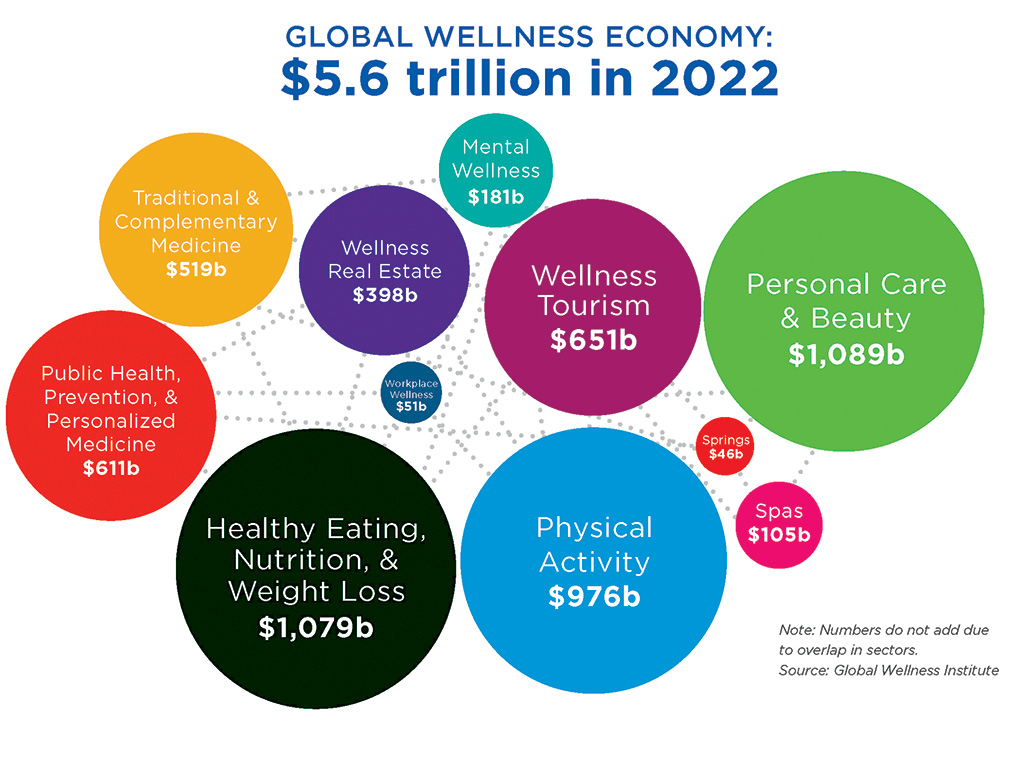For the next five years, the global wellness economy will grow at a robust rate of 8.6 per cent annually from
nearly $6.3 trillion in 2023 ($5.6 trillion in 2022), the GWI report predicts.
Wellness boom: Targeting $8.5 trillion market by 2027


With the new focus seen worldwide towards health and wellbeing, the wellness economy has exceeded its pre-pandemic levels and reached new heights, says a Global Wellness Institute (GWI) report.
The report, Global Wellness Economy Monitor 2023, predicts that the wellness economy will continue its robust growth and expand its share of consumer spending and the global economy over the next several years.
For the next five years, the global wellness economy will grow at a robust rate of 8.6 per cent annually and march toward $8.5 trillion in 2027 from nearly $6.3 trillion in 2023 ($5.6 trillion in 2022), the report predicts.
By 2027, the global wellness economy will represent 6.6 per cent of global GDP, compared to 5.6 per cent in 2022, the report says.
GWI defines the wellness economy as industries that enable consumers to incorporate wellness activities and lifestyles into their daily lives. In its definition, the wellness economy encompasses 11 varied and diverse sectors.
“There is no question that consumer interest in all things related to wellness has been rising rapidly, and in many ways, interest accelerated during the pandemic (even as consumer spending on wellness declined). There is also a growing awareness of the environmental determinants of health, whether we are at home, at work, in our community, or traveling. Wellness has expanded to encompass many more stakeholder groups beyond hospitality and recreation; it is being embraced by employers, schools, public health, urban planning, and more – and these stakeholders will increasingly take wellness to the masses,” the report highlights.
Most of the individual wellness sectors are projected to exceed global GDP growth in the next five years. Some of the sectors with the highest growth projections (e.g., wellness tourism, thermal/mineral springs) are those that took the greatest hit in 2020. The growth rates for these sectors may seem abnormally high because they reflect a continued period of recovery from 2023-2025, and they are then expected to taper off to a growth trajectory similar to their pre-pandemic levels.
Both the wellness tourism and spa sectors are projected to have recovered and exceeded their pre-pandemic levels in 2023. The global thermal/mineral springs sector will take a little longer, until 2024, for a full recovery. Other sectors that maintained positive growth during the 2020 pandemic, including wellness real estate and mental wellness, are projected to continue their robust growth trends in the coming years.
The report forecasts that four wellness sectors – personal care & beauty; healthy eating, nutrition & weight loss; physical activity; and wellness tourism – will exceed $1 trillion in market size in 2024. It also projects that three sectors – wellness real estate; traditional & complementary medicine; and public health, prevention & personalised medicine – will exceed half a trillion dollars in 2024.
The report sees healthy eating, nutrition & weight loss becoming the largest segment in the wellness economy by 2025, and with its ongoing strong growth rate, wellness real estate will enter the top five sectors in the same year.
All global regions have recovered from the pandemic, but North America, Europe, and the Middle East-North Africa have shown the strongest resilience and growth from 2019-2022.
In 2022, North America surpassed Asia-Pacific to become the largest regional wellness economy, a shift that has occurred due to relatively slower growth and recovery in some major Asian markets. North America ($1.9 trillion), Asia-Pacific ($1.7 trillion), and Europe ($1.5 trillion) together account for 90% of the entire global wellness economy. Per capita spending on wellness is significantly higher in North America ($5,108) and Europe ($1,596) than in other regions of the world.
GWI defines wellness as: the active pursuit of activities, choices, and lifestyles that lead to a state of holistic health. Wellness extends beyond physical health and incorporates many different dimensions that should work in harmony.